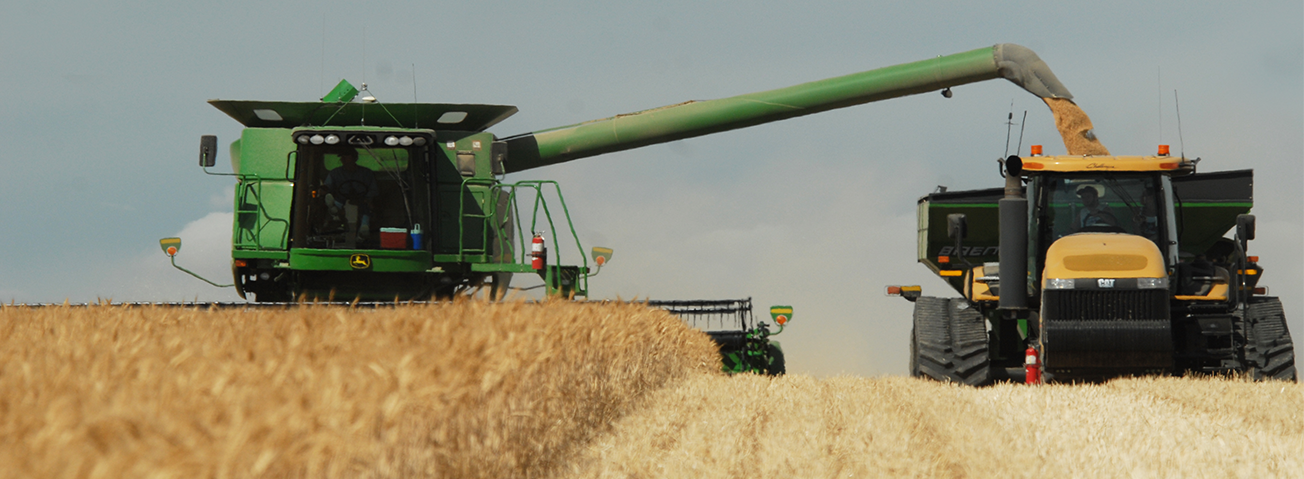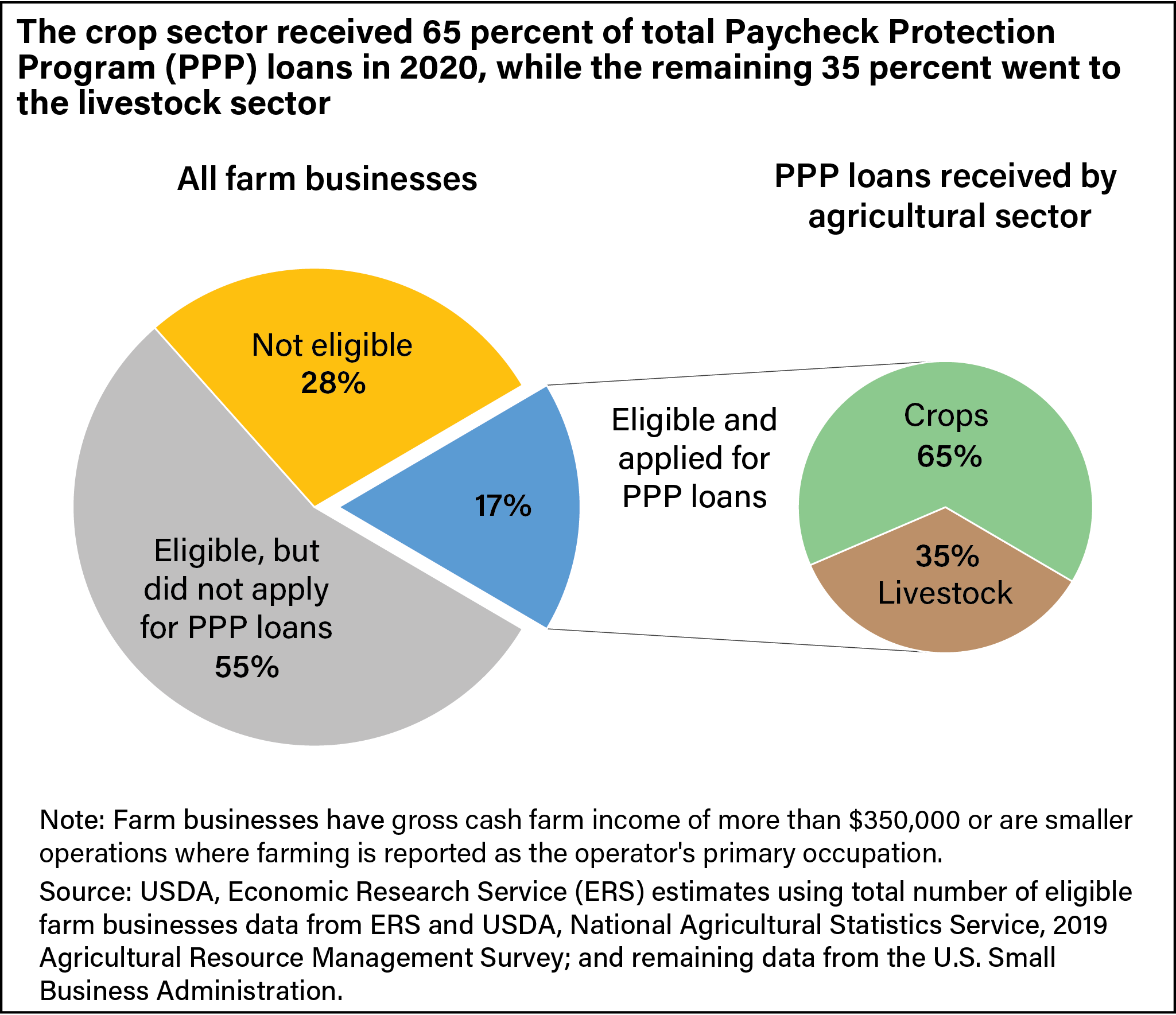
U.S. Farm Producers Received Almost $6 Billion From the Paycheck Protection Program in 2020
- by Anil K. Giri, Dipak Subedi and Tia M. McDonald
- 10/4/2021
As part of its response to the Coronavirus (COVID-19) pandemic, the U.S. Federal Government implemented the Paycheck Protection Program (PPP), one of many stimulus and relief measures designed to aid consumers and businesses, including agricultural producers. Agricultural producers could use forgivable loans from this program to help keep employees on payroll and offset some of their operating costs. The maximum PPP loan amount was 2.5 times the monthly average profit plus payroll and eligible overhead expenses (such as the employer’s share of insurance payments and unemployment taxes). PPP loans were forgivable if used within 24 weeks after the first disbursement of the loan on eligible expenses.
Data from the U.S. Small Business Administration (SBA) showed that more than $525 billion in PPP payments were disbursed through more than 5.2 million loans in 2020. Although little information on PPP recipients was available, researchers from USDA’s Economic Research Service (ERS) examined information collected in USDA’s 2019 Agricultural Resource Management Survey (ARMS). According to ARMS, 72 percent of all farm businesses (operations with gross cash farm income of more than $350,000 or smaller where farming is reported as the operator's primary occupation) had either positive net income or paid labor—and, therefore, would meet the two most important eligibility requirements to apply for PPP loans.
Individual SBA loan data revealed that almost 121,000 farm operations applied for a total of $6.0 billion in PPP loans. That would account for 17 percent of farm businesses presumed eligible based on the 2019 ARMS. Of the total PPP loans that went to farm operations, $2.1 billion (35 percent) went to livestock operations and the remaining $3.9 billion (65 percent) went to crop operations. Fifty-five percent of all farm businesses did not apply for a PPP loan.
Recipients of a PPP loan had to use at least 60 percent on payroll expenses for the loan to be fully forgiven. To provide insights into annual payroll expenses relative to the total PPP loan, researchers assumed that the actual share of PPP loans used for payroll expenses fell between 100 percent (the entire loan was spent on payroll) and 60 percent (producers met the minimum requirement for forgiveness). Under these assumptions, PPP loans amounted to somewhere between 13 percent and 22 percent of the hired labor expenses by the agricultural sector.
Errata: On November 12, 2021, the text and chart were revised to clarify that the Paycheck Protection Program eligibility simulation was carried out on both commercial and intermediate farm operations. No other data or findings are changed.
This article is drawn from:
- Giri, A.K., Subedi, D., Peterson, E.W.F. & McDonald, T.M. (2021). Impact of the Paycheck Protection Program on U.S. Producers. Choices, Quarter 3. https://www.choicesmagazine.org/choices-magazine/theme-articles/rural-development-implications-one-year-after-covid-19/impact-of-the-paycheck-protection-program-on-us--producers.
You may also like:
- ARMS Farm Financial and Crop Production Practices. (n.d.). U.S. Department of Agriculture, Economic Research Service.
- Key, N. (2019, October 22). Larger Farms and Younger Farmers Are More Vulnerable to Financial Stress. Amber Waves, U.S. Department of Agriculture, Economic Research Service.
- Farm Income and Wealth Statistics. (n.d.). U.S. Department of Agriculture, Economic Research Service.
- Giri, A.K., McDonald, T.M., Subedi, D. & Whitt, C. (2021, September 7). U.S. Agriculture Sector Received an Estimated $35 Billion in COVID-19-Related Assistance in 2020. Amber Waves, U.S. Department of Agriculture, Economic Research Service.
- Subedi, D., Giri, A.K. & McDonald, T.M. (2021, July 6). Commercial Farms Received the Most Government Payments in 2019. Amber Waves, U.S. Department of Agriculture, Economic Research Service.
- Farm Sector Income & Finances. (n.d.). U.S. Department of Agriculture, Economic Research Service.
- Farm Household Well-being. (n.d.). U.S. Department of Agriculture, Economic Research Service.
- Farm Household Income and Characteristics. (n.d.). U.S. Department of Agriculture, Economic Research Service.
- Giri, A.K., McDonald, T.M., Subedi, D. & Whitt, C. (2021). COVID-19 Working Paper: Financial Assistance for Farm Operations and Farm Households in the Face of COVID-19. U.S. Department of Agriculture, Economic Research Service. AP-090.
- Whitt, C., Todd, J.E. & MacDonald, J.M. (2020). America's Diverse Family Farms: 2020 Edition. U.S. Department of Agriculture, Economic Research Service. EIB-220.
- Lyons, G. (2019). Financial Conditions in the U.S. Agricultural Sector: Historical Comparisons. U.S. Department of Agriculture, Economic Research Service. EIB-211.
- Litkowski, C. & Law, J. (2021). COVID-19 Working Paper: A Timely Tool for Evaluating Financial Conditions in Agriculture: USDA Forecasts of the Value of Production in the Face of COVID-19. U.S. Department of Agriculture, Economic Research Service. AP-086.
We’d welcome your feedback!
Would you be willing to answer a few quick questions about your experience?


